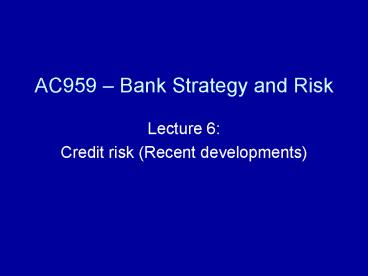AC959 Bank Strategy and Risk - PowerPoint PPT Presentation
1 / 27
Title:
AC959 Bank Strategy and Risk
Description:
Understand the importance of credit ratings to credit risk ... Credit ratings. Rating categories. Types of bonds. Historical default rates. AC959 - Lecture 6 ... – PowerPoint PPT presentation
Number of Views:14
Avg rating:3.0/5.0
Title: AC959 Bank Strategy and Risk
1
AC959 Bank Strategy and Risk
- Lecture 6
- Credit risk (Recent developments)
2
Aims of lecture
- Understand the key recent developments in credit
risk management - Understand the importance of credit ratings to
credit risk - Explain how the following assist in managing
credit risk - Credit default swaps
- Asset securitisation
- Credit risk modelling
3
Credit ratings
- Rating categories
- Types of bonds
- Historical default rates
4
Credit derivatives
- Credit derivatives are financial contracts that
involve a potential exchange of payments in which
at least one of the cash flows is linked to the
performance of a specified underlying
credit-sensitive asset. So credit derivatives are
financial contracts that enable participants to
trade in credit as an asset, as they isolate and
transfer credit risk.
5
Credit Events
- Bankruptcy
- Failure to Pay
- Obligation Acceleration
- Obligation Default
- Debt Moratorium
- Restructuring and Modified Restructuring
6
Example of Credit Default Swap (CDS)
7
Benefits of CDS to banks
- Transfer credit risk / reduce credit exposure
- Reference credit is unaware protect
relationships - Transfer risk on illiquid assets
- Protection seller obtains access to credit risk
of reference assets diversify own portfolio
8
Asset Securitisation
- The process whereby loans, receivables and other
financial assets are pooled together, with their
cash flows or economic values redirected to
support payments on related securities. These
securities, which are generally referred to as
asset-backed securities or ABS are issued and
sold to investors by issuers, who utilise
securitisation to finance their business
activities. - European Securitisation Forum
9
Securitisation - Impact on bank B/S
10
Benefits of securitisation
- Remove poorly performing assets from the balance
sheet enhance profitability - Provide capital
- Transfer credit risk OBS
- Protect relationships
- Transfer illiquid assets
- Buyer of ABS obtains access to new asset classes
11
Credit Risk Modelling
- Move from individual credit risks to modelling
the credit risk of the portfolio - Lower regulatory capital charge
- Off the shelf models
- CreditMetrics
- CreditRisk
- KMV Portfolio Manager
- Bespoke models
12
(No Transcript)
13
Key modelling terms
- Exposure at default (EAD)
- Loss given default (LGD)
- LGD EAD X (1-recovery rate )
- Default probability (DP)
14
Recovery rate percentages
15
Credit modelling example
- Two-asset portfolio
- Asset 1 BBB rated bond
- Asset 2 A rated bond
- Risk horizon One-year
16
Transition matrix
17
BBB bond transition matrix
18
BBB bond future value
19
BBB bond value and probability
20
BBB bond probability distribution
21
A bond values in one year
22
A bond transition matrix
23
Possible portfolio values
24
Joint probability likelihoods correlation 0.3
25
Joint probability distribution
26
Benefits of credit risk modelling
- Expands credit risk approaches to measure and
model portfolio credit risk - Calculate appropriate capital
- Calculate marginal credit risk of a new asset in
the portfolio - Monitor the relationships between different assets
27
Concerns with credit risk modelling
- Forecast accuracy of models
- Require regular evaluation of the model
back-testing - Only as good as the specification
- Rely on historical data
- Costly for smaller banks to implement































